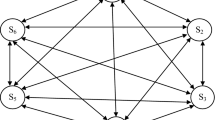Abstract
In the global economy, the modern commercial and industrial organization needs to develop better methods of assessing the performance of the human resource than simply using performance measures such as efficiency or effectiveness. As organizations seek more aggressive ways to cut costs and to increase global competitiveness, the importance of establishing and sustaining high levels of employee performance increases. The main purpose of this paper is to solve the human performance improvement problem by employing Analytic Hierarchy Process (AHP) method. Decision makers (DMs) often deal with problems that involve multiple criteria. At given moments in time, companies will display characteristics that make certain factors; key factors in their competences. In this paper, we present a model, which illustrates the relations and importance between human performance improvement and the style of management. In using the AHP to model this problem, we developed a hierarchic structure to represent the problem of human performance management and made pairwise comparisons. In this paper, the AHP is suggested as a tool for implementing a multiple criteria performance improvement scheme. The AHP was used for the purpose of structuring and clarifying the relations and importance between human performance improvement and the style of management. The study found that in terms of company culture, participation, human capability, and attitudes the best management style in improving human performance is management by values.
Similar content being viewed by others
References
Argyris, C. (1971) Management and Organizational Development, McGraw-Hill, New York.
Arthur, J. R. (1994) Effects of human resource systems on manufacturing performance and turnover. Academy of Management Journal, 37, 670–687.
Brown, O. Jr. (1996) Participatory ergonomics: From participation research to high involvement ergonomics. In Human Factors in Organization Design and Management, Vol. V, Brown, O. Jr. and Hendrick, H. W. (eds.), North-Holland, Amsterdam, pp. 187–192.
Carroll, S. and Tosi, H. (1973) Management by Objectives, Macmillan, New York.
Chiu, R. K. (1998) Employee involvement in a total quality management programme: problem in Chinese firms in Hong Kong. Quality and Management, 14(June/July), 8–11.
Cotton, J. L. (1993) Employee Involvement: Methods for Improving Performance and Work Attitudes, SAGE Publications, London.
Dale, B., Cooper, C. and Wilkinson, H. (1997) Managing Quality and Human Resources: A Guide to Continuous Improvement, 2nd edition, Blackwell, Oxford.
Department of Trade and Industry (DTI). (1991) Organisation, People and Technology: An executive guide, Manufacturing Technology Division, DTI, London.
Drucker, P. F. (1995) Managing in a Time of Great Change, Truman Talley, New York.
Flynn, B., Schroeder, R. and Sakakibara, S. (1995) The impact of quality management practices on performance and competitive advantage. The Journal of the Decision Sciences, 26(5).
Golden, L. B., Wasil, A. E. and Harker, T. P. (1989) The Analytic Hierarchy Process, Springer-Verlag, Berlin, Heidelberg, New York.
Griffin, R. (1993) Management, 4th edition, Houghton Mifflin Company.
Head, C. W. (1997) Beyond Corporate Transformation: A Whole Systems Approach to Creating and Sustaining High Performance, Productivity Press, Portland.
Hendrick, H. W. (1979) Differences in group problem solving behavior and effectiveness as a function of abstractness. Journal of Applied Pschology, 64, 518–525.
Hendrick, H. W. (1981) Abstractness, conceptual systems, and the functioning of complex organizations, in The Functioning of Complex Organizations, England, G., Negandh, A. and Wilpert, B. (eds.), Oelgeschalger, Gunn and Hain, Cambridge, MA, pp. 25–50.
Hendrick, H. W. (1990) Perceptual accuracy of self and others and leadership status as functions of cognitive complexity, in Measures of Leadership, Clark, K. E. and Clark, M. B. (eds.), Leadership Library in America, West Orange, NJ, 511–520.
Hendrick, H. W. (2001) Macroergonomics: An Introduction To Work System Design, Published by Human Factors and Ergonomics Society.
Huber, V. L. and Brown, K. A. (1991) Human resource issues in cellular manufacturing: Associotechnical analysis. Journal of Operations Management, 11, 138–159.
Hyman, J. and Mason, B. (1995) Managing Employee Involvement and Participation, SAGE Publications, London.
Keidel, R. W. (1994) Rethinking organizational design. Academy of Management Executive, 8(4), 12–30.
Lawler, E. E. III, Mohrmann, S. A. and Ledford, G. E. Jr. (1995) Creative High Performance Organization: Practices and Results of Employee Involvement and Total Quality, in Management in Fortune 1000 Companies, Jossey-Bass, San Francisco, CA.
Lawrence, P. R. and Lorsch, J. W. (1969) Organization and Environment, Irwin, Homewood, IL.
Phuong Ta, H. and Yin Har, K. (2000) A Study of Bank Selection Decisions in Singapore using the Analytical Hierarchy Process. International Journal of Bank Marketing, 18(4), 170–180.
Rangone, A. (1996) An Analytical Hierarchy Process Framework for Comparing the Overall Performance of Manufacturing Departments. International Journal Operations and Production Management, 16(8), 104–119.
Rao, A., Carr, L., Dambolena, I., Kopp, R., Martin, J., Rao, E. and Schlesinger, P. (1996) Total Quality Management, Wiley, New York. Saaty, T. L. (1994) The Analytical Hierarchy Process, 2nd edition, McGraw-Hill, New York.
Saaty, T. L. (1994) Fundamentals of Decision Making and Priority Theory, RWS Publications.
Saaty, T. L. (1994) How to Make a Decision: The Analytic Hierarchy Process. Interfaces, 24(6), 19–43.
Shalley, C., Oldham, G. and Porac, J. (1987) Effects of goal difficulty, goal setting method and expected external evaluation on intrinsic motivation. Academy of Management Journal, 30, 553–566.
Schein E. G. (1985) Organizational Culture and Leadership, Jossey-Bass Publishers, San Francisco.
Tseo, G. K. Y. and Ramos, E. L. (1995) Employee empowerment: Solution to a burgeoning crisis? Challenge, 38(September/October), 25–31.
Wood, S. and Albanese, M. T. (1995) Can we speak of a high commitment management on the shop floor. Journal of Management Studies, 32, 215–247.
Yankelovich, D. (1979) Work Values and the New Breed, Van Nostran Reinhold, New York.
Yoon, K. P. H. and Ching-lai H. (1995) Multiple Attribute Decision Making, Sage Publications, London.
Author information
Authors and Affiliations
Rights and permissions
About this article
Cite this article
Albayrak, E., Erensal, Y.C. Using analytic hierarchy process (AHP) to improve human performance: An application of multiple criteria decision making problem. Journal of Intelligent Manufacturing 15, 491–503 (2004). https://doi.org/10.1023/B:JIMS.0000034112.00652.4c
Issue Date:
DOI: https://doi.org/10.1023/B:JIMS.0000034112.00652.4c




